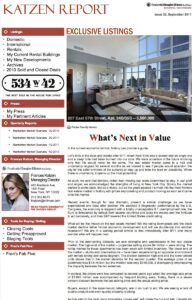In the current economic turmoil, history can provide a guide.
Let’s look at the days and weeks after 9/11, when New York was a scared and an angry city and a deep hole had been burned into our core. We were uncertain of the future knowing only that life would never be the same. The real estate market came to a halt and uncertainty reigned for several months as we looked to see if people would abandon the city for the safer environs of the suburbs or step up and take the lead on possibility. When there is uncertainty, it opens up the most possibility.
As such, we saw that families, rather than moving out, were determined to stay. In our grief and anger, we acknowledged the strengths of living in New York City. Slowly the market started to come back, first as a trickle, but as the years passed it turned into the most frenetic real estate market in history with prices skyrocketing and product moving as soon as it came onto the market.
Recent events, though far less dramatic, present a similar challenge as we have experienced one blow after another. We watched a disgraceful performance by the U.S. Congress, the economy is stagnant with a totally unacceptable 9.1 unemployment rate, the Euro is threatened by default from several countries and lacks the means and the fortitude to act decisively, and then S&P lowered the United States credit rating.
What will be the impact on the real estate market? Will the rating downgrade and the stock market decline father hinder economic development and will we double-dip into another recession? We are in a waiting period similar to that immediately after 9/11 and many wonder what will happen next.
Prior to the debt-ceiling debacle, we saw strengths and weaknesses in the real estate market. The high-end of the market – properties selling above $4 million – were strong. The rental market for these apartments has been weak with limited inventory. The lower end of the market – studio and one-bedrooms – have been experiencing an opposite environment with rentals strong and sales stagnant. The division between high-end and the lower priced units shows that in the market statistics for the second quarter. The average price of an apartment was $1.6 million, but the median was only $915,000, a discrepancy emphasizing the disparity between the two extremes.
In context, the prices were low compared to several years ago when the average sale price of $1.995 million was accompanied by frequent bidding wars. Today, there is a seven percent discount between the last asking price and the actual selling price.
Buyers, except in the super-luxury category, are in no rush to act. We are seeing a lack of quality product and even quality property is sitting.
As I’ve said in the past, good properties, priced well, will make the cut and sell. I repeat: for sellers, pricing of their product is the key. Many buyers, however, do not understand what constitutes value. Too many look for a bargain rather than value and ignore the significant amount of value at current prices.
In the current uncertain environment, we can expect to see buyers pulling back because either they now lack the funds or they believe prices will go much lower. We will probably have fewer buyers and possibly less inventory.
Prior to recent events, we have been optimistic with luxury product coming onto the market and improving the variety of Grade-A real estate available. Down the road, in two or three years, new super-luxury properties will appear with aggressive pricing in the $5,000 to $6,000/sf range. These new properties could change the perception of value and create the high tide that lifts prices across the market, or, the impact could be concentrated on the upper stratosphere only.
New Yorkers are known for their resilience and can-do attitude as we have viewed time and time again. For now, we believe buyers who consider going against the grain will benefit. But I believe that these traits will allow us to get through the current period of economic decline and uncertainty. If we look at history this typically becomes the profound foundation for an opportunistic and resilient real estate market.

